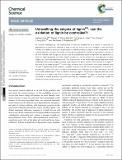Files in this item
Unravelling the Enigma of ligninOX : can the oxidation of lignin be controlled?
Item metadata
| dc.contributor.author | Guo, Haiwei | |
| dc.contributor.author | Miles-Barrett, Daniel | |
| dc.contributor.author | Neal, Andrew | |
| dc.contributor.author | Zhang, Tao | |
| dc.contributor.author | Li, Changzhi | |
| dc.contributor.author | Westwood, Nicholas James | |
| dc.date.accessioned | 2017-12-18T17:30:20Z | |
| dc.date.available | 2017-12-18T17:30:20Z | |
| dc.date.issued | 2018-01-21 | |
| dc.identifier | 251752355 | |
| dc.identifier | 34c00c91-38db-44af-87b8-622d5dbd50b1 | |
| dc.identifier | 85040832376 | |
| dc.identifier | 000422947000022 | |
| dc.identifier.citation | Guo , H , Miles-Barrett , D , Neal , A , Zhang , T , Li , C & Westwood , N J 2018 , ' Unravelling the Enigma of lignin OX : can the oxidation of lignin be controlled? ' , Chemical Science , vol. 9 , no. 3 , pp. 702-711 . https://doi.org/10.1039/C7SC03520A | en |
| dc.identifier.issn | 2041-6520 | |
| dc.identifier.other | ORCID: /0000-0003-0630-0138/work/56424162 | |
| dc.identifier.uri | https://hdl.handle.net/10023/12355 | |
| dc.description | This work was supported by the National Natural Science Foundation of China (21690080, 21690083, 21473187), the Strategic Priority Research Program of the Chinese Academy of Sciences (XDB17020100), China Scholarship Council (GH) and by EPSRC grant (EP/1518175), the Industrial Biotechnology Innovation Centre (IBioIC) (DMB PhD studentship). | en |
| dc.description.abstract | As societal challenges go, the development of efficient biorefineries as a means of reducing our dependence on petroleum refineries is high on the list. One of the core strengths of the petroleum refinery is its ability to produce a huge range of different products using all of the components of the starting material. In contrast, the target of using all the biopolymers present in lignocellulosic biomass is far from realised. Even though our ability to use the carbohydrate-based components has advanced, our plans for lignin lag behind (with the notable exception of vanillin production). One approach to lignin usage is its controlled depolymerisation. This study focuses on an increasingly popular approach to this challenge which involves highly selective lignin oxidation to give a material often referred to as ligninOX. But what do we mean by ligninOX? In this study we show that it is possible to form many different types of ligninOX depending on the oxidation conditions that are used. We show that variations in the levels of processing of the β-O-4, the β-β and a third linkage occur. Through use of this information, we can form a well-defined ligninOX from six different hardwood lignins. This process is reproducible and can be carried out on a large scale. With a source of well-defined ligninOX in hand, we show that it can be converted to simple aromatic monomers and that any remaining ligninOX is sufficiently soluble for further processing to be carried out. | |
| dc.format.extent | 1775657 | |
| dc.language.iso | eng | |
| dc.relation.ispartof | Chemical Science | en |
| dc.subject | QD Chemistry | en |
| dc.subject | DAS | en |
| dc.subject.lcc | QD | en |
| dc.title | Unravelling the Enigma of ligninOX : can the oxidation of lignin be controlled? | en |
| dc.type | Journal article | en |
| dc.contributor.institution | University of St Andrews. School of Chemistry | en |
| dc.contributor.institution | University of St Andrews. EaSTCHEM | en |
| dc.contributor.institution | University of St Andrews. Biomedical Sciences Research Complex | en |
| dc.identifier.doi | 10.1039/C7SC03520A | |
| dc.description.status | Peer reviewed | en |
| dc.identifier.url | http://www.rsc.org/suppdata/c7/sc/c7sc03520a/c7sc03520a1.pdf | en |
This item appears in the following Collection(s)
Items in the St Andrews Research Repository are protected by copyright, with all rights reserved, unless otherwise indicated.

